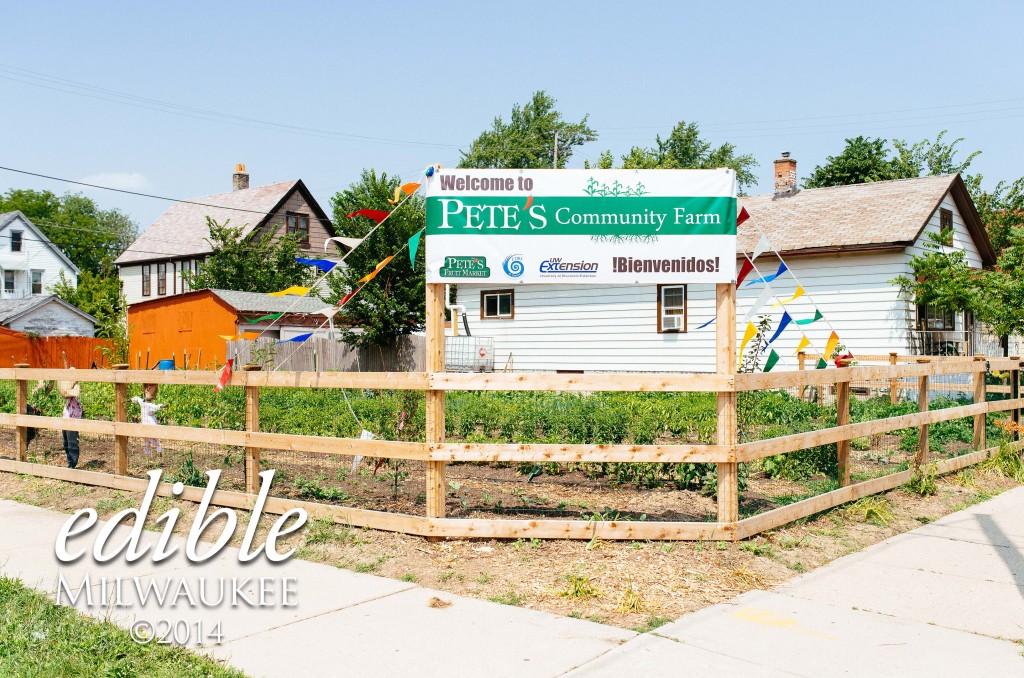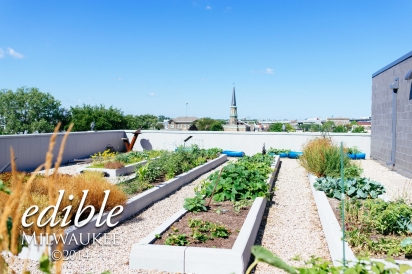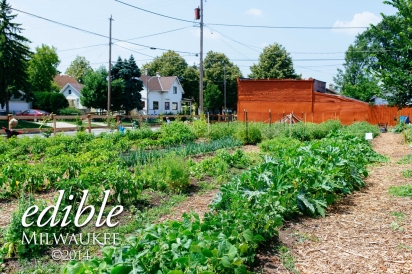Making Elecciones Saludables (Healthy Choices)
Milwaukee’s Latino community seeks access to healthy food
There’s a serene spot in the city with breathtaking views. Look up and you can see Milwaukee icons like the Allen-Bradley Clock Tower and The Basilica of St. Josaphat. Look down, however, and you see neat rows of peppers, lettuce and squash next to towering plants of chamomile, tomato and corn.
On the rooftop of Walker’s Point’s new Clock Shadow Building, a small nonprofit is catalyzing a community health movement by growing fresh produce. Situated between the city’s flourishing dining district and the predominantly Hispanic South Side, CORE/El Centro serves a diverse population hungry for change.
On a Monday night in summer at CORE, adults of every age zigzag, chacha, and shake to a Zumba routine, while their kids receive healthy snacks and learn how veggies grow. This is all part of CORE’s Garden and Nutrition program that has been able to reach its full potential since moving into its new building (130 W. Bruce Street) in 2012. The organization serves over 4,000 families a year with its programming and estimates about half take part in the nutrition classes.
Stephanie Calloway, nutrition program coordinator, is using the 1,000- square-foot rooftop garden as a springboard to promote healthy lifestyles. She also runs CORE’s summer camps that provide hands-on workshops for students ages 6-13 where they learn how to grow, cultivate and harvest produce and herbs in accordance with USDA organic standards. “The ultimate goal of the camp is to bring the youth closer to the earth, understand the impact that we have on our environment and give them tools to live a healthier lifestyle,” said Calloway. “The participants were put into groups on day one and each group was responsible for preparing and/or serving the snacks and lunch for one day of the camp.” As part of the nutrition programing, families can also purchase fresh produce and prepared fare from a handful of vendors at the Monday night farmers market.
CORE partners with several other organizations including the Milwaukee Food Council, UW-Extension and the South Side EAT (Empowerment, Access, Transformation) Coalition to inspire policy change for a strong local food system while celebrating the neighborhood’s diversity.
Another trailblazer in the area’s healthy lifestyle movement is the Sixteenth Street Community Health Center. Through its Healthy Choices Program, 70 percent of adult participants lose 1-20 pounds and many more maintain their current weight. “Change is happening because there is a need and an urgency,” says Tatiana Maida of the Clinic.
Census figures from 2011 show that over the past decade in Milwaukee, the Latino population grew 74 percent. Sadly, so have the rates of obesity: 41 percent of Latino teens are overweight and 21 percent are obese. Maida is the Healthy Choices (Elecciones Saludables) Coordinator; the four-year-old bilingual program serves 100 families a year—though she gets hundreds more referrals through the clinic. Many families who are clients of the clinic are are battling morbid obesity and its residual effects in children as young as four years old.
The nominal enrollment fee for families helps hold them accountable for attending the classes and workshops that focus on healthy cooking, exercise and making healthy choices at restaurants. The 12-week program is one of the only programs across the country that is tailored to teens and adults, not just children, serving four age groups altogether. Maida feels especially proud when she hears participants talk about lifestyle changes she promotes through the program—like when children remind their parents to buy wheat bread not white at the market, and women share how they substitute the traditional manteca (lard) in beans for olive oil.The attendance rates vary from 68-75 percent, which Maida calls a big success, given that “you are telling people things they don’t want to hear.”
The obesity-prevention program is more concerned with educating about quality food than weight loss, says Maida. They also focus on increased consumption of water and vegetables while decreasing soda, red meat, processed foods and sugar. Most families in the program are of Mexican descent, so a big challenge is showing families that they can still have their favorite dishes, but preparing them differently and monitoring portions is key.
“We tell them they can still have a tortilla, but just one, not the entire package. Add vegetables to your quesadilla or chose a tortilla over the bolillo (dense Mexican roll),” Maida instructs. The real problem lies in American fast food like hamburgers, hot dogs and chips working their way into Mexican families’ traditional diets. “Mexican cuisine did not become unhealthy until it came to America,” said Maida.
Healthy Choices empowers families not just to make better choices, but also to manage stress and emotions, and to stick together as a family. In most cases, obesity is a family problem, and anxiety, depression and stress cause overeating.
Another important pillar of the program is teaching community leadership that encourages peer-to-peer education. Graduates of the Healthy Choices program have come together to form Latinos por el Salud (Latinos for Health), a community health advocacy group that organizes bike rides, walks and other opportunities for physical activity and healthy eating. Maida finds that when the family starts eating better, the community improves.
In 2012, Healthy Choices and Latinos por el Salud led a grocery store campaign with on-site education, and requested El Rey (1023 S. Cesar E. Chavez Dr.) and Pete’s Fruit Market (1400 S. Union St.) to expand their healthy offerings to hormone-free dairy and meat, whole grains like quinoa, sesame, and flax, and organic produce. Both stores have fully embraced this request and now stock whole grain breads, cookies, crackers, and cereals without high fructose corn syrup, whole-wheat flour, quinoa, sesame, nonfat/low-fat milk and dairy, cage-free eggs without antibiotics, and baked chips.
Pete’s even went a step further. Last spring, they collaborated with CORE/El Centro and the UW-Extension to transform three vacant lots about a block and half away from the market into a small farm, complete with chickens and soon, honeybees. The fruits and vegetables—tomatoes, peppers, beans, corn, squash, lettuce, carrots, raspberries, strawberries and more—are available for purchase at a Wednesday night farmers market on site and at Pete’s. Robert Heotis, the general manager at Pete’s, sees this as their way to educate and organize the community while creating a footprint for more urban gardens. Both Heotis and Calloway agree that one of the more challenging aspects of the project has been keeping all partners moving on the same page without a dedicated coordinator. “It’s been great to see a group of passionate and busy people come together to make this project happen in just three months,” says Calloway.
With the support of Calloway’s summer camp students and the guidance of Cesar Cena, a Mayan elder with years of agricultural experience, and Ryan Schone, an urban agriculture specialist with UW-Extension, they will be harvesting their first crop this fall.








